Did you know that some of the most alien-like creations of nature are not from the depths of outer space but can actually be found growing in your garden, at a farmer’s market, or maybe even on your plate? From prickly exteriors to otherworldly shapes and textures, edible plants with bizarre appearances captivate not just our culinary imaginations but often leave a lasting impression with their unique aesthetics. These “alien-looking” plants are as fascinating in appearance as they are rich in flavor and nutritional value. Let’s dive into the mysteriously exquisite world of peculiar edible plants where every bite tells a one-of-a-kind story.
The Crinkled Oddity: Buddha’s Hand Citrus
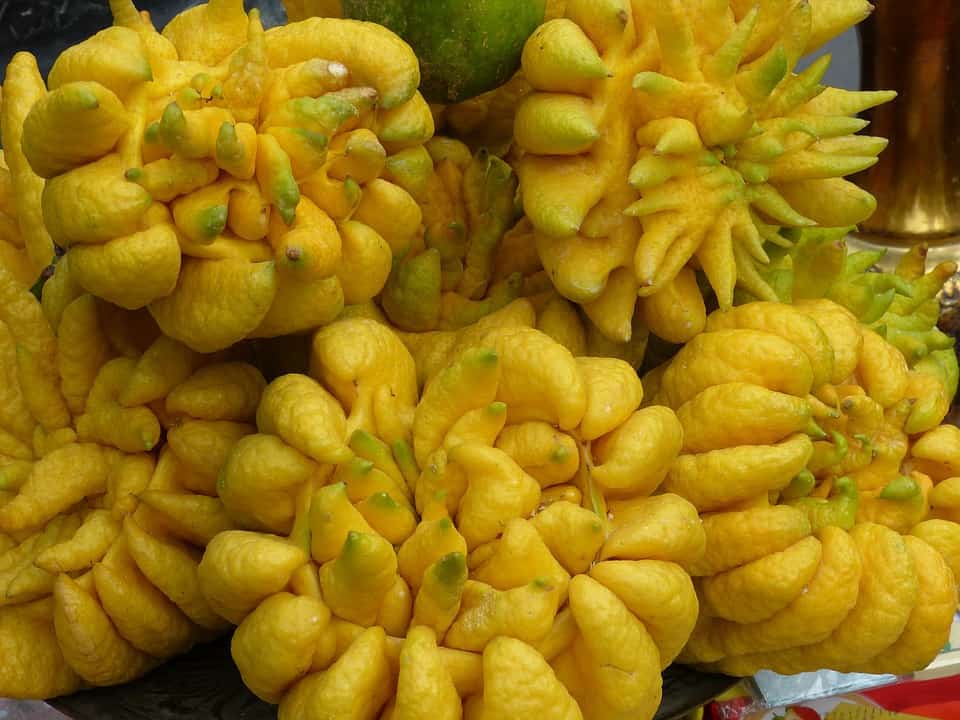
This peculiar fruit takes organic surrealism to new heights. Resembling floating golden tentacles or illuminated fingers, the Buddha’s Hand Citrus is an extraordinary piece in both aesthetic and culinary terms. It lacks the traditional juicy interior of most citrus fruits but compensates with its zest-rich, fragrant skin. Shades of golden yellow dominate, with subtle green highlights near the tips. The curved “fingers” are textured and crinkled, creating an intricate visual pattern that feels alive.
Mood and Style: This fruit radiates a sense of awe, evoking exotic and mystical allure. Beyond its raw aesthetic appeal, it symbolizes good fortune in many cultures, making it a delightful gift. Its vibrant color and unusual shape bring immediate energy to any fruit basket or decorative table arrangement.
Actionable Tip: Use Buddha’s Hand as a dramatic element for home staging or add thinly sliced zest to pastries or infused liquors for a complex, aromatic kick.
Spiky and Vibrant: Kiwano (Horned Melon)
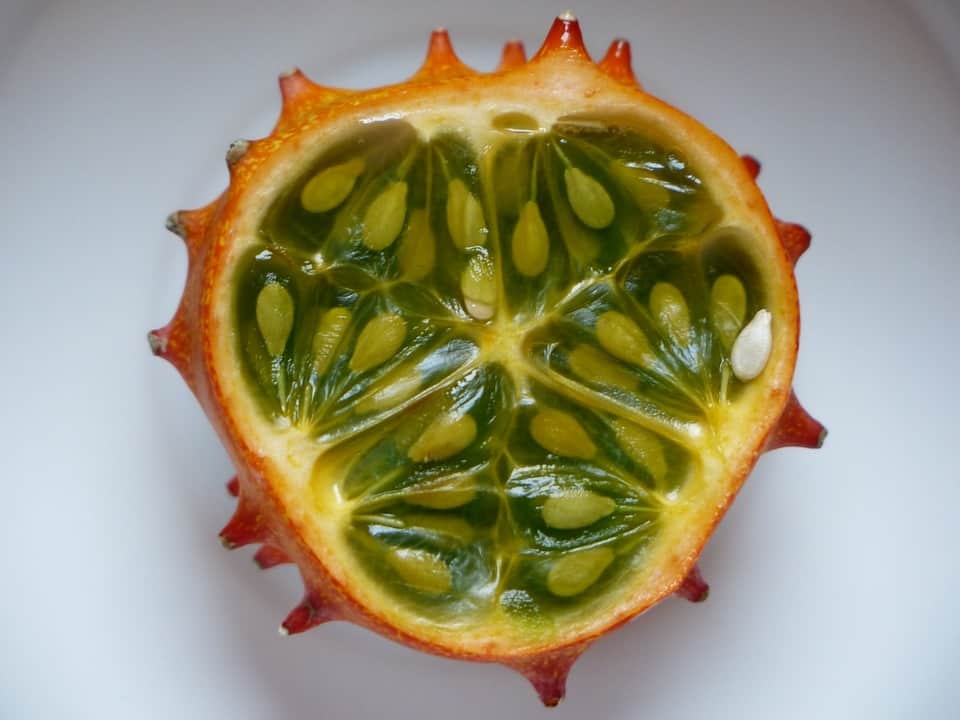
With its vividly orange, spiked exterior and neon green, gel-like flesh inside, the Kiwano stands out as one of nature’s most colorful anomalies. The prickles along the outer skin seem to spring out in random clusters, giving it an untamed, almost wild character. When sliced open, the inside reveals translucent green seeds suspended in a jelly-like substance—a stark contrast to its bold, fiery exoskeleton.
Mood and Style: The Kiwano feels playful yet foreign, combining a touch of whimsy with its futuristic edge. Its eye-catching nature makes it a captivating display piece for food photography, or it could serve as a tropical conversation starter placed in a decorative fruit bowl.
Actionable Tip: Pair Kiwano with neutral tones to enhance its vibrancy. Serve the sliced fruit in clear glass dishes to showcase its translucent green flesh, or create a smoothie bowl incorporating its unique texture.
A Ruby from Space: Imbe Fruit
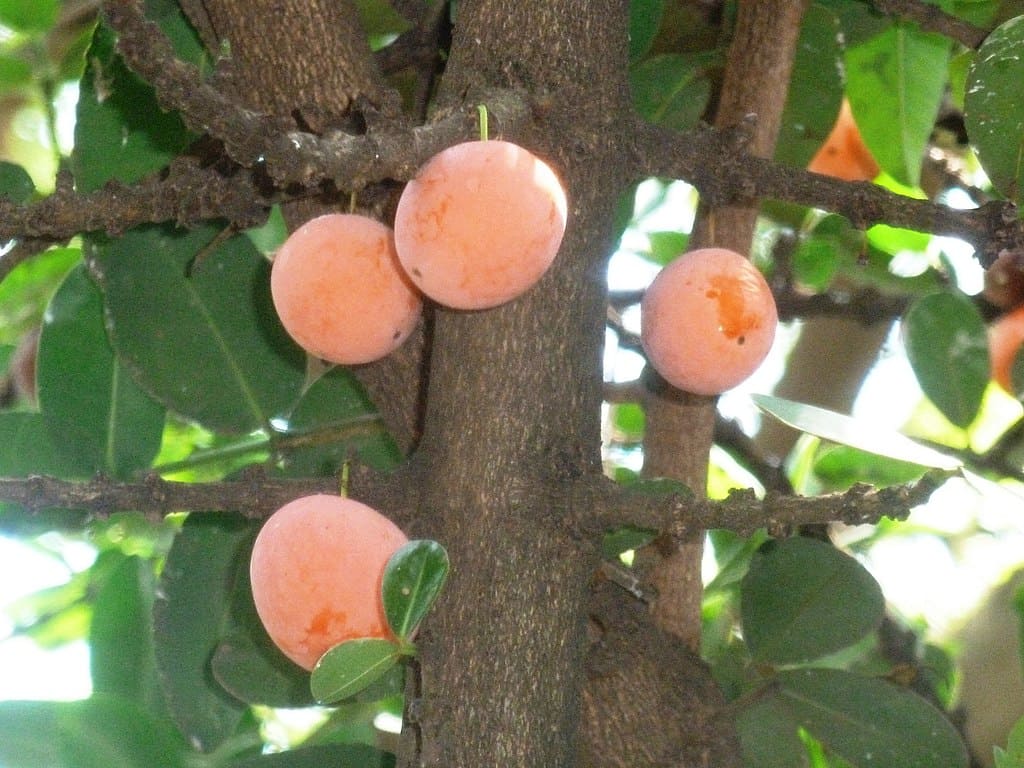
At first glance, Imbe fruit can be likened to miniature planets, glowing in their reddish-orange vibrancy. Typically small and spherical, these fruits have smooth, glossy skin that reflects light beautifully, adding an almost jewel-like quality. The transition of colors, fading from orange to ruby red, makes it a striking addition to any setting. Despite its compact size, the Imbe is packed with sweetness and tang, creating an unforgettable taste experience.
Mood and Style: Perfect as an ornamental fruit bowl filler or a topping for artisanal desserts, the Imbe fruit communicates cheerful simplicity with a touch of exotic allure. Its petite size makes it ideal for garnishing cocktails or plating in modern culinary presentations.
Actionable Tip: Highlight Imbe fruit’s natural beauty by incorporating it into centerpieces with greenery or complementing it with rose-gold metallic serving trays.
Monstera Deliciosa: The Tropical Encounter
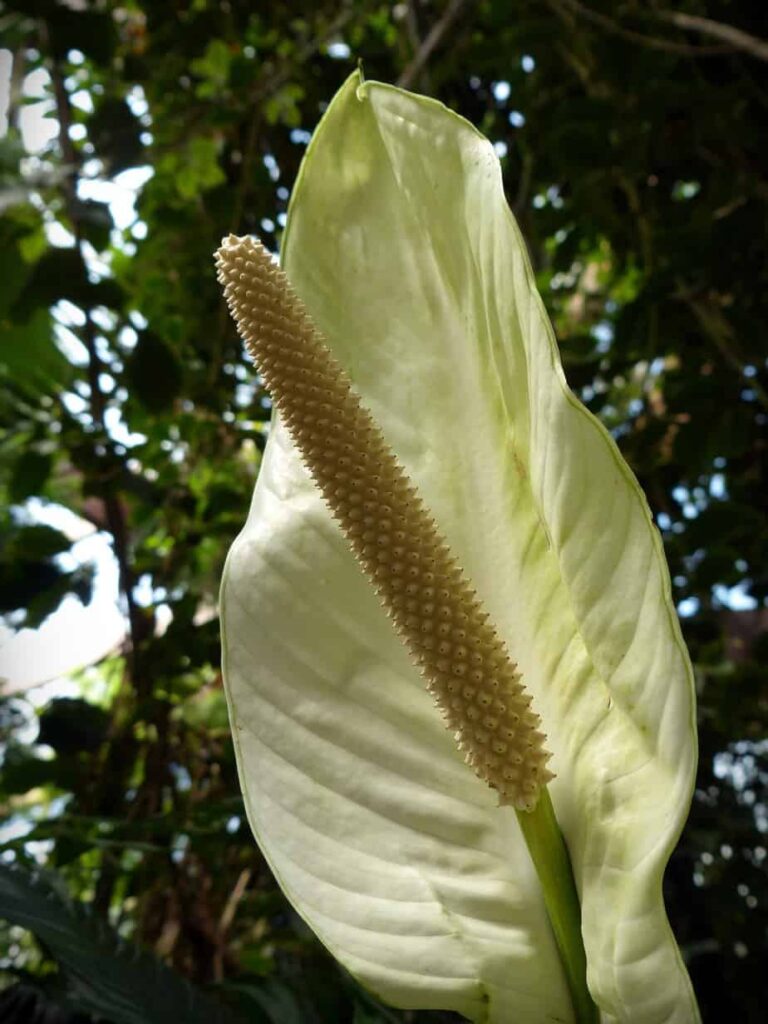
Known for its iconic foliage in interiors, the Monstera Deliciosa also bears edible fruit that looks as strange as it tastes delicious. The cylindrical shape, covered in armored, hexagonal green scales, adds a textural intrigue reminiscent of ancient reptilian artifacts. As it ripens, the scales fall away, revealing its edible, creamy white flesh that tastes like a cross between pineapple and banana.
Mood and Style: Monstera’s fruit carries a tropical vibe that feels adventurous and energizing. Used as an unexpected decor element, it complements lush greenery displays and jungle-inspired tablescapes. The ripe segments add both a fresh taste and an exotic visual to breakfast or dessert spreads.
Actionable Tip: Incorporate Monstera fruit into creative plates for tropical-themed parties, or display alongside monstera leaves for a cohesive botanical statement.
A Burst of Purple Power: Acai Berries

Tiny yet mighty, acai berries bring a royal, alien-esque allure to the culinary world. Their rich, dark purple hue almost verges on black, reflecting a mysterious and luxurious vibe. The small, round fruits often appear as if polished, their smooth surface adding a glossy texture to their unique aesthetic. When turned into puree or blended into smoothie bowls, their deep color creates a visually mesmerizing contrast against vibrant toppings like bananas, granola, or tropical fruits.
Mood and Style: Acai berries offer a chic, health-conscious vibe that resonates with wellness enthusiasts. Their rich color and versatility make them perfect for creating Instagram-worthy dishes or vibrant tablescape accents.
Actionable Tip: For an easy yet striking display, pile acai berries in a textured ceramic bowl or feature an acai smoothie bowl topped with fresh fruit, edible flowers, and seeds for an edible art piece that doubles as a nutritious treat.
Hidden Beauty: Passion Fruit
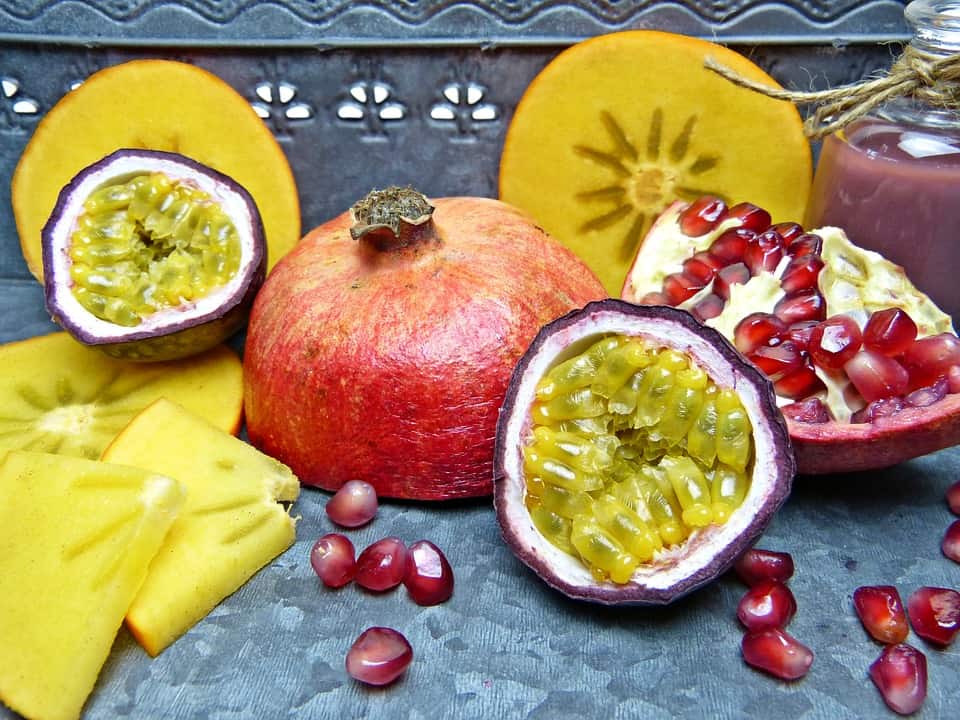
Passion fruits are truly dual-natured—unassuming on the outside and vibrant on the inside. Their rugged, wrinkly exterior, often in shades of dark purple or yellow, hints at their hidden treasure. Slice one open, and the explosion of bright yellow-orange pulp dotted with black seeds feels like peering into another dimension. The glossy texture of the pulp is undeniably enticing, and its tropical aroma intensifies the sensory experience.
Mood and Style: This fruit exudes an irresistible tropical charm, adding energy and vibrancy to any table. Its striking colors and gelatinous appearance make it perfect for modern and rustic decor alike.
Actionable Tip: Use halved passion fruits as edible garnishes for cocktails or desserts, letting their juicy interiors shine. They also pair beautifully with neutral dishware to highlight their intense hues.
The Alien Heart: Atemoya
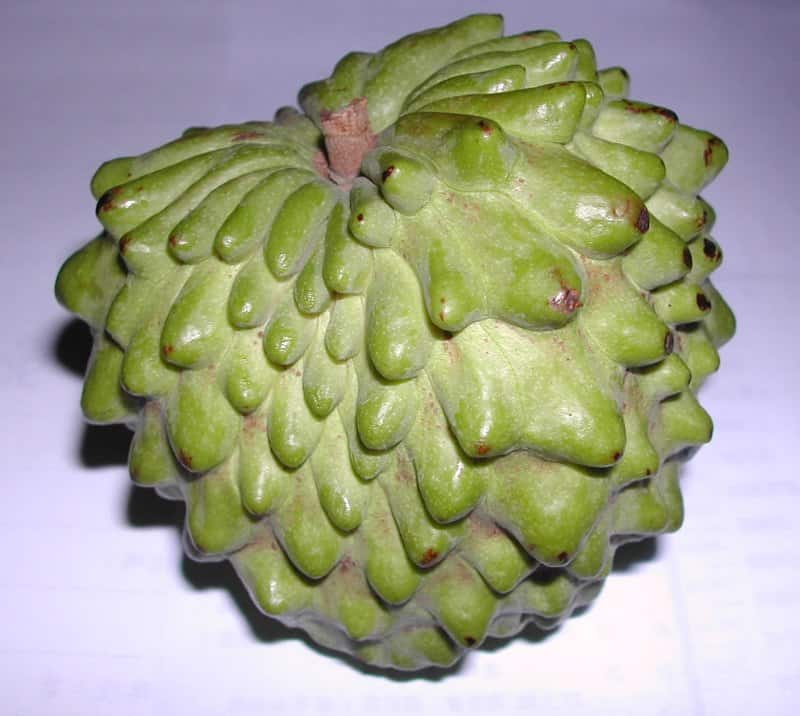
Atemoya combines the surreal textures of alien art with the comforting softness of tropical fruit. Shaped like a heart or a bulbous pinecone, its scaley surface in shades of pale green and creamy white lends it an unmistakable presence. When sliced open, its snowy flesh reveals black seeds sprinkled throughout, offering a striking visual contrast. With its naturally sweet flavor profile, Atemoya represents a perfect blend of beauty and taste.
Mood and Style: Atemoya feels grounding yet exotic, evoking a sense of curiosity with its sculptural form. Its heart-shaped silhouette makes it an ideal conversation piece for elegant dining spreads or exotic fruit platters.
Actionable Tip: Place Atemoya among dark-toned fruits like plums or red grapes for a dramatic contrast, or serve sliced pieces on natural wood boards to play up its rustic sophistication.
Sunset Hues: Tamarillo
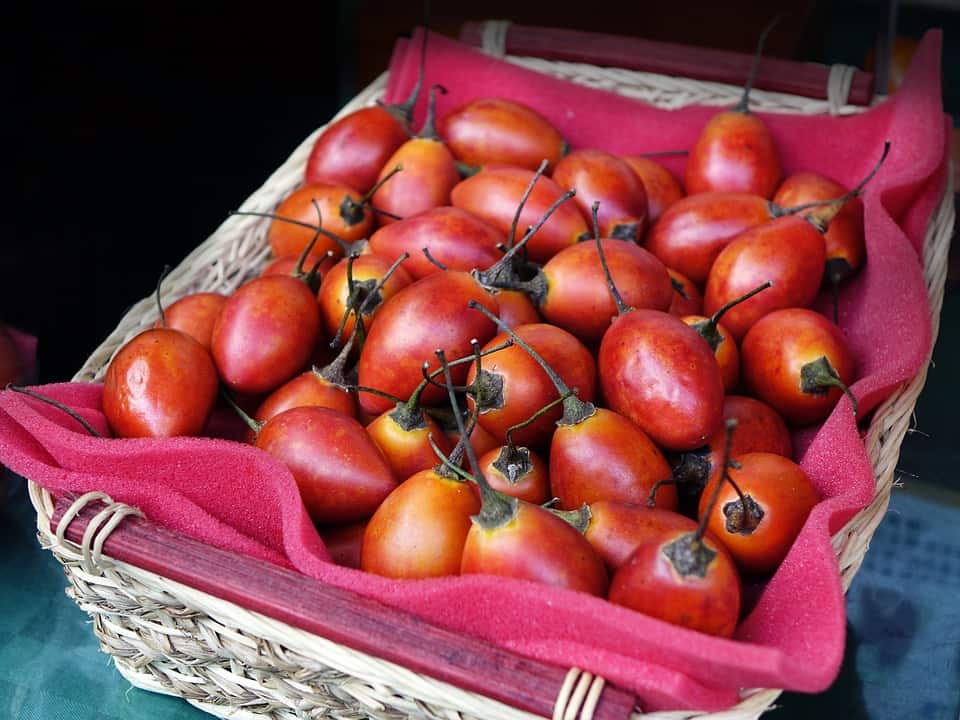
Tamarillo, often referred to as the tree tomato, brings a dazzling gradient of sunset-inspired hues to the table. Its smooth, oval shell ranges from deep orange to ruby-red, transitioning seamlessly like watercolor art. Slice it open, and the vibrant inner pulp is revealed, dotted with tiny edible black seeds that resemble constellations. The flesh is smooth and juicy, offering both tart and sweet notes that make it a versatile kitchen ingredient.
Mood and Style: Tamarillo feels dynamic and energizing, perfect for brightening up minimalist or neutral tablescapes. It’s ideal for culinary experiments or as a standout visual display in fruit bowls.
Actionable Tip: Use halved Tamarillos as a garnish for salads or serve slices arranged in concentric circles on monochrome plates for a visual feast. To highlight its vivid hues, pair it with white ceramic dishes or light wooden platters.
Chocolate’s Mysterious Cousin: Black Sapote

Unassuming from the outside, Black Sapote surprises with its deep, almost ink-black interior flesh when ripe. Its earthy brown-green skin exterior belies the velvety, indulgent, pudding-like texture within, earning it the nickname “chocolate pudding fruit.” The interior boasts a glossy, soft consistency and an alluring richness in color, reminiscent of pure cocoa.
Mood and Style: Black Sapote feels indulgent and decadent, creating an atmosphere of comfort and understated luxury. Despite its otherworldly appearance, it’s a versatile fruit for both culinary creators and decor enthusiasts.
Actionable Tip: Feature Black Sapote alongside nuts, dark chocolate shavings, and fresh cream for a decadent dessert presentation. For decor purposes, place it whole and sliced in natural wicker trays for a rustic yet stylish touch.
Deep Crimson Beauty: Mulberries
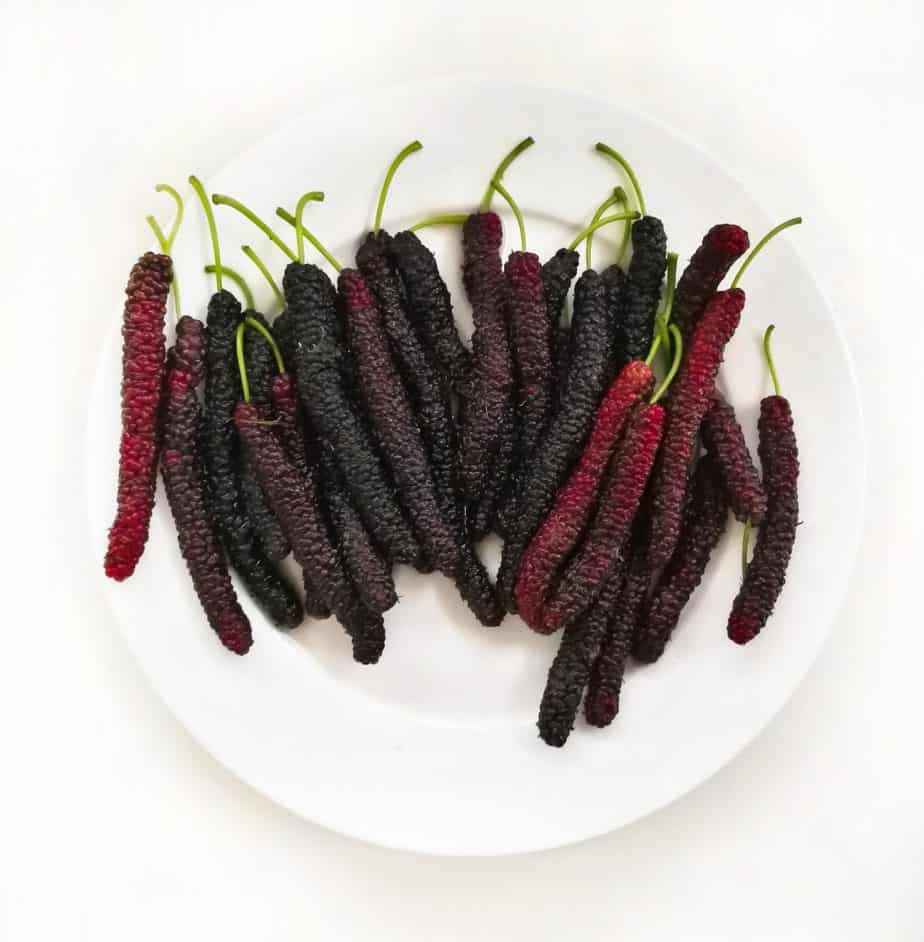
Mulberries are the epitome of richness in both color and form. These elongated, clustered fruits look like tiny, alien berries sprouting from thin, delicate stems. Their skin varies from deep crimson to nearly black, creating a striking visual gradient that captures attention immediately. Each fruit is textured with a bumpy surface, adding an intriguing tactile dimension to their beauty. The juice within radiates vibrancy, often staining fingers with shades as dark and bold as their outer skin.
Mood and Style: Mulberries evoke a sense of opulence and nature’s artistry, perfect for enhancing rustic or vintage tablescapes. Whether served fresh or paired with desserts, their textured look adds complexity and drama to any presentation.
Actionable Tip: Scatter mulberries over neutral-toned linens for a gorgeous, organic centerpiece or use them to create vibrant sauces that elevate your favorite desserts visually and flavorfully.
Golden Gems: Jocote
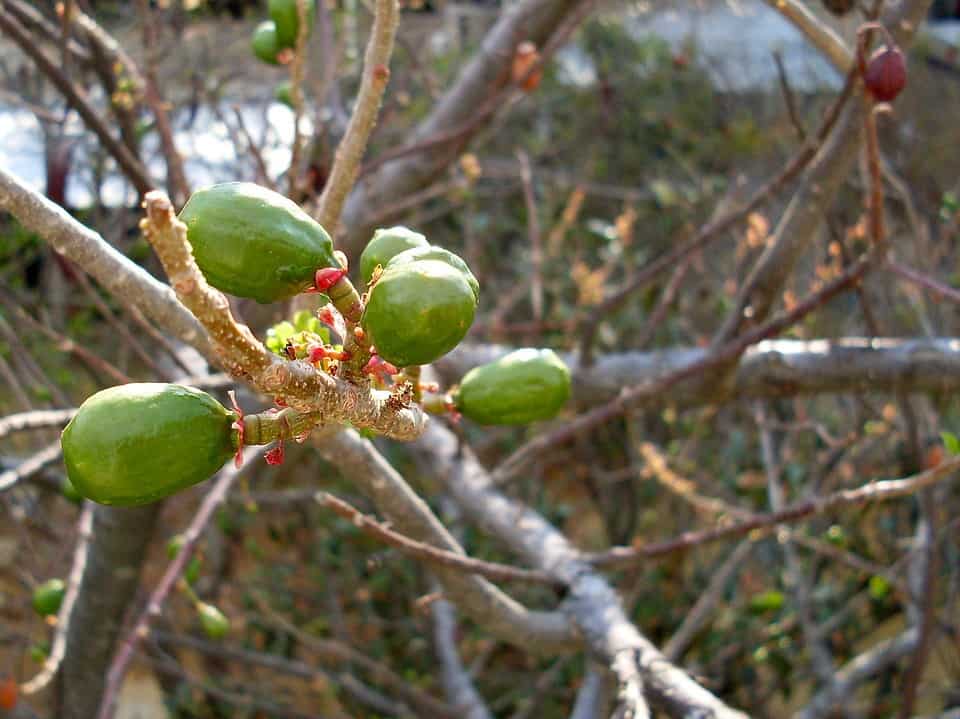
Jocotes, also known as hog plums, resemble compact, golden gems with a smooth, glossy exterior ranging from bright yellow to deep orange or red. Their spherical shape and radiant hues give off a sun-kissed impression, while their firm, waxy surface glimmers under light. These small fruits pack a subtly tangy punch, offering both visual and culinary intrigue. Their petite size makes them ideal for adding pops of vibrant color to any decor or dish.
Mood and Style: Radiating tropical charm, Jocotes are ideal for island-inspired settings or adding energy to a minimalist fruit bowl. Their vibrant tones create an instant party vibe, making them a must-have for festive gatherings.
Actionable Tip: Arrange Jocotes in a wooden or ceramic bowl with green foliage accents for a warm, tropical look. Alternatively, use them to create a colorful, tangy chutney to pair with cheeses or grilled dishes.
Desert Jewel: Barrel Cactus Fruit
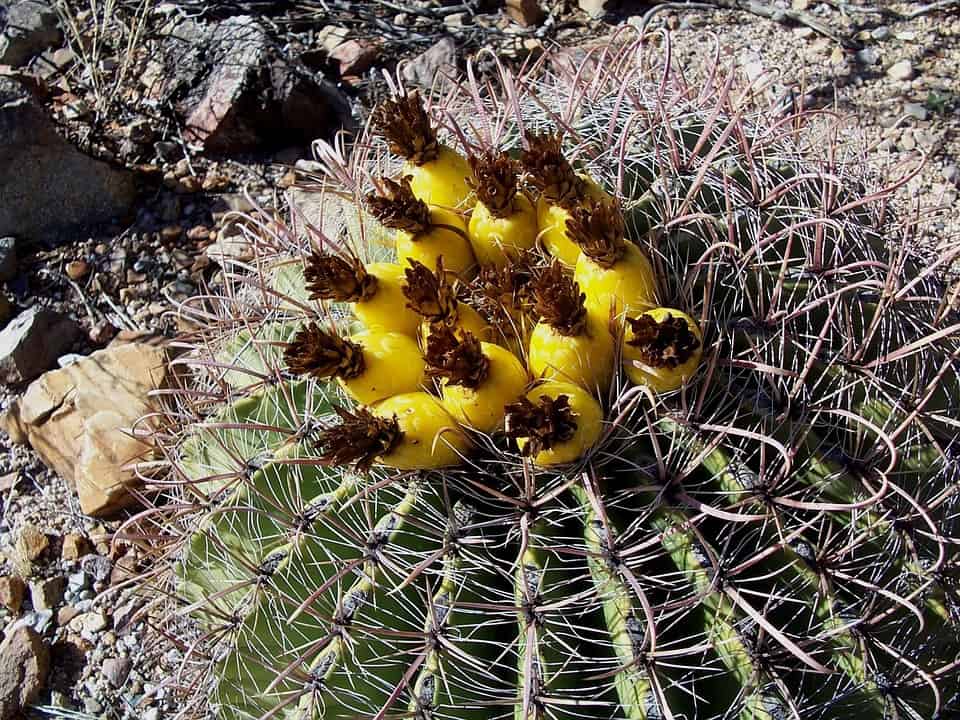
The fruit of the barrel cactus is as captivatingly strange as it is beautiful, resembling small-rounded crowns with spiked edges. Its radiant yellow tone is akin to desert sunlight, contrasted by the natural green of the cactus needles surrounding it. The fruit’s unique shape, detailed with subtle ridges and a bulbous base, gives it an almost architectural quality. It looks as if it comes from another world, blending rugged and luminous elements seamlessly.
Mood and Style: Barrel cactus fruit brings an earthy, desert-inspired charm to any setting. Its bold yellows and naturally rugged aesthetic pair beautifully with modern ceramic vases or rugged stone-inspired decor.
Actionable Tip: Display barrel cactus fruit in a minimalist, sand-colored dish to enhance its desert-inspired appeal, or slice it in half and pair it with green succulents for an unusual centerpiece.
Rich and Creamy Marvel: Cupuaçu
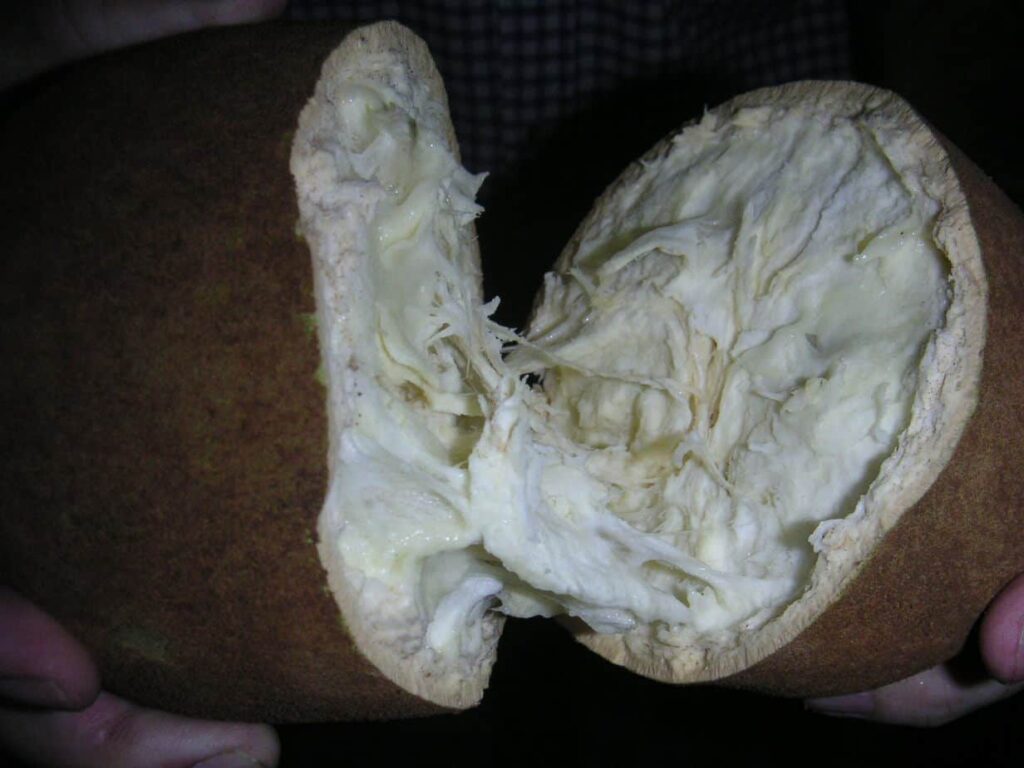
Cupuaçu is the chocolate-like cousin of cacao, with an exterior that looks just as fascinating as its luxurious flavor. The fruit’s thick, velvety brown shell resembles a rich leather finish, while its large, oval shape exudes presence and sophistication. Crack it open, and its creamy, aromatic pulp offers a sensory explosion. Known for its tropical essence, cupuaçu’s ivory interior contrasts beautifully with the darker and rougher exterior, drawing immediate focus.
Mood and Style: Cupuaçu feels earthy yet indulgent, blending raw wilderness with exotic elegance. As a decor piece, it pairs beautifully with lush greenery or natural wood textures for a rustic, tropical theme.
Actionable Tip: Place a whole cupuaçu fruit next to bright, citrusy fruits for visual contrast, or showcase its sliced interior in a monochrome setting to highlight its creamy textures. Sprinkle its shavings over desserts or whip it into smoothies for a bold, tropical treat.
Floral Alien Fantasy: Hala Fruit
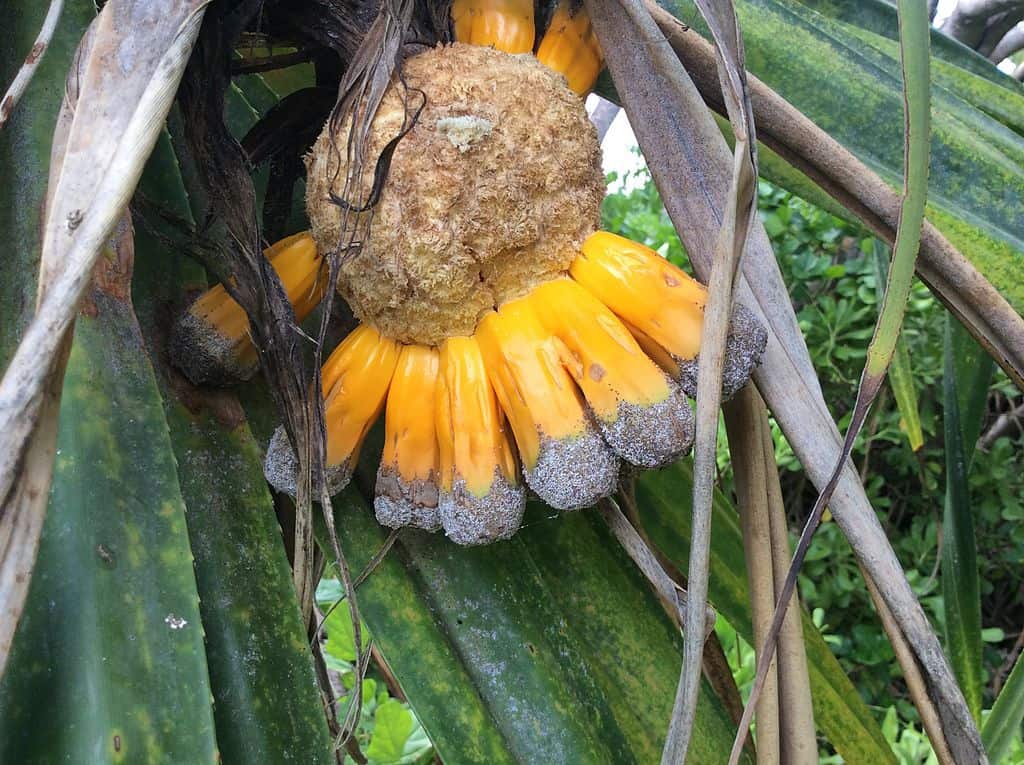
The Hala fruit, also known as the pandanus fruit, is a true spectacle of natural design. Its spiky, clustered segments resemble a surreal alien flower, with a kaleidoscope of colors blending orange, yellow, and green. Each cone-shaped segment bursts out like the petals of an otherworldly bloom, creating a strong textural and visual contrast. The detailed, geometric symmetry of each individual piece makes it both a creative natural composition and an artistic wonder.
Mood and Style: Hala fruit captivates with its exotic, vibrant energy, making a bold statement in tropical or eclectic decor styling. Its intricate geometry adds dynamism to natural tablescapes and imagery.
Actionable Tip: Use Hala fruit segments as playful garnishes for tropical drinks, or display the entire fruit as a standalone art piece in a neutral-toned environment to maximize its vibrancy and texture.
Let’s keep exploring the wonders of alien-look edible plants!
Mamey Sapote: Velvet Treasure
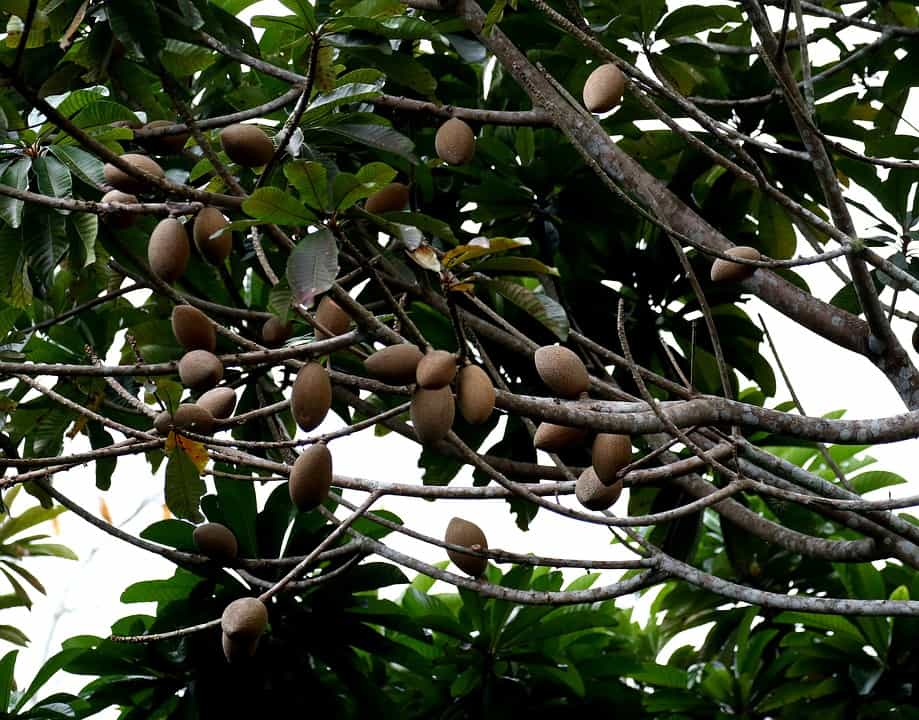
The Mamey Sapote is nature’s velvet treasure—a tropical fruit with a rough, brown exterior that belies its vibrant interior. Once sliced open, the fruit reveals incredibly smooth and rich orange-colored flesh that exudes warmth and vitality. Its texture is notably creamy, almost akin to a dense custard, making it perfect for smoothies and desserts. The large, glossy black pit nestled at its center adds contrast and visual intrigue.
Mood and Style: Mamey Sapote radiates natural elegance with its velvety exterior and sumptuous interior. It’s ideal for rustic or boho-style presentations; arrange slices of it on wooden serving boards or in earthy ceramic dishes to emphasize its tropical roots.
Actionable Tip: Pair thin slices of Mamey Sapote with other jewel-toned fruits like mangoes or pomegranates for a vibrant and lush fruit platter. Its creamy texture also makes it an excellent base for non-dairy ice creams or spreads.
Rose Apple: A Floral Delight

True to its name, the Rose Apple’s beauty is reminiscent of delicate blooms. With its soft, blushing pink skin and subtly curved shape, it almost looks like a flower ready to unfurl. The texture is smooth, and the deeper pink tones at its tips fade gently into pale creamy shades toward the center. Its light, crisp flesh carries a faint fragrance of roses, making it adorably whimsical.
Mood and Style: The Rose Apple captures a pure, romantic vibe—ideal for floral-themed table arrangements or a whimsical garden party. Its gentle colors and delicate form add an ethereal quality to fruit bowls or dining spreads.
Actionable Tip: Slice Rose Apples thinly to uncover their unique circular patterns, then use them to garnish salads or dessert platters. Pair them with fresh blooms or edible flowers for a cohesive floral presentation.
Wood Apple: Earthy Elegance
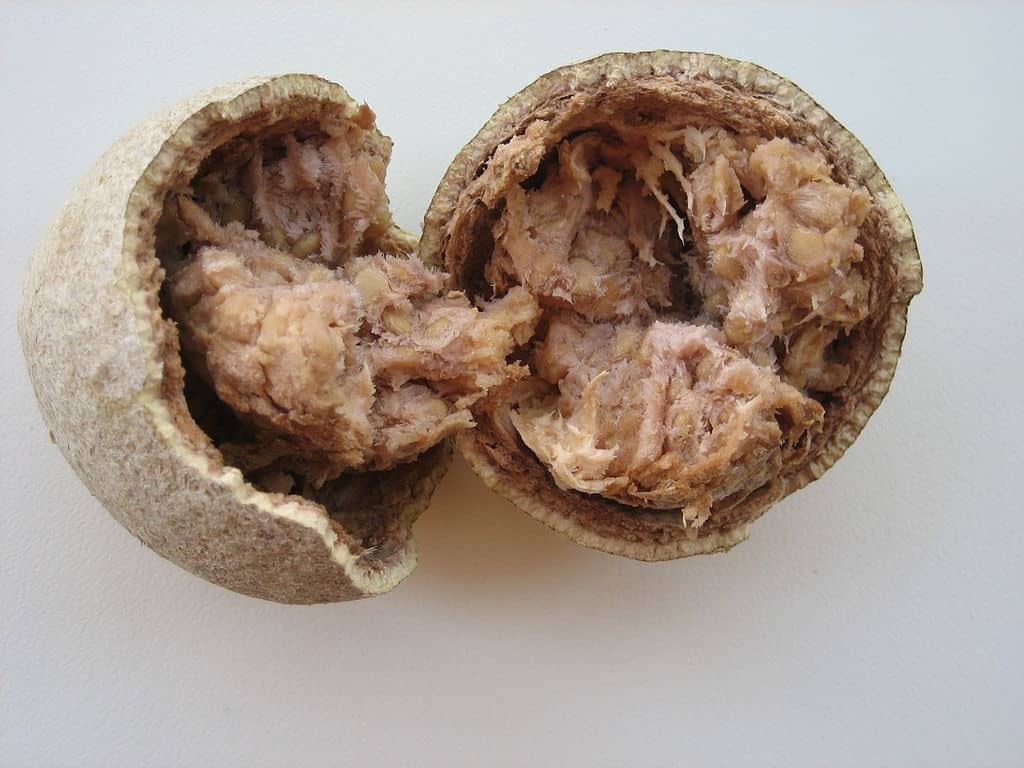
The Wood Apple stands out with its rugged, earthy exterior that resembles aged bark, giving it an ancient and mystical appearance. Cracking it open reveals a fibrous orange-brown interior, filled with aromatic pulp often used in refreshing drinks or chutneys. Its unassuming yet fascinating look makes it a visual standout in any setting.
Mood and Style: The Wood Apple emanates rustic charm, perfect for vintage or earthy kitchens. Its textured surface contrasts beautifully with modern ceramic dishes, creating an eclectic and grounded feel.
Actionable Tip: Use whole Wood Apples as a natural centerpiece in tablescapes focused on tropical or rustic themes. Complement their earthy aesthetic with dark wooden boards or pottery for a cohesive look.
Safou: The African Butterfruit
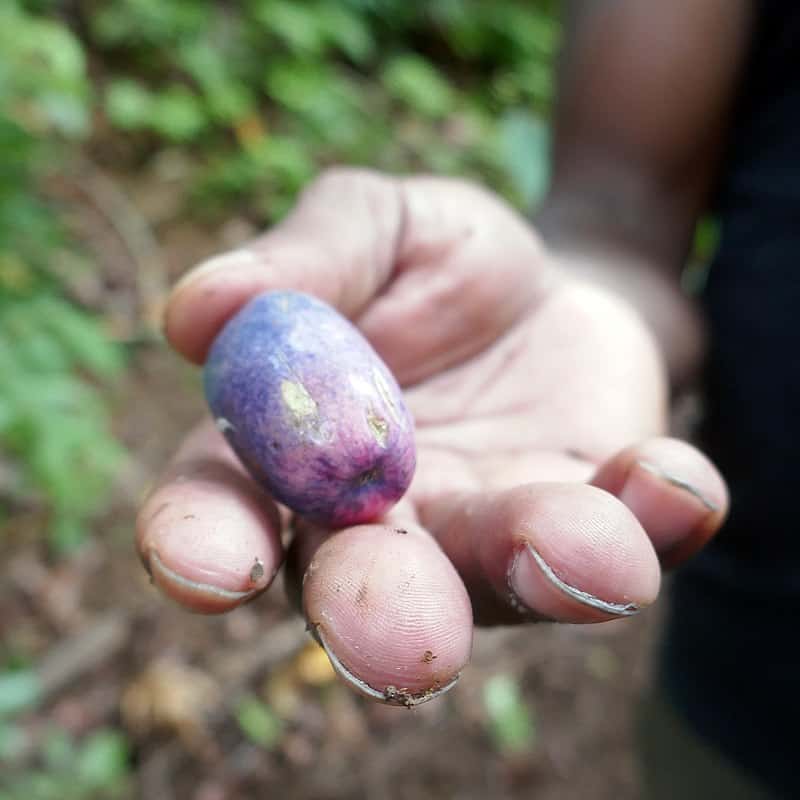
Safou, also known as African Butterfruit, offers an exotic visual with its elongated shape and stunning deep blue to purple skin. The surface appears almost velvety, creating a tactile appeal, while the fruit’s juicy, bright green interior adds an unexpected pop of color when split open. Its buttery texture and bold color palette make it a striking addition to any edible arrangement.
Mood and Style: Safou communicates boldness and sophistication, with its deep tones perfect for dramatic, moody settings. Its alien-like duality—dark skin and vibrant interior—lends it to creative plating in modern and exotic styles.
Actionable Tip: Serve Safou halved over black or metallic plates to emphasize its striking colors. Alternatively, roast them whole with herbs for a unique side dish that doubles as a decor element.
Strawberry Tree Fruit: Nature’s Miniature Lanterns
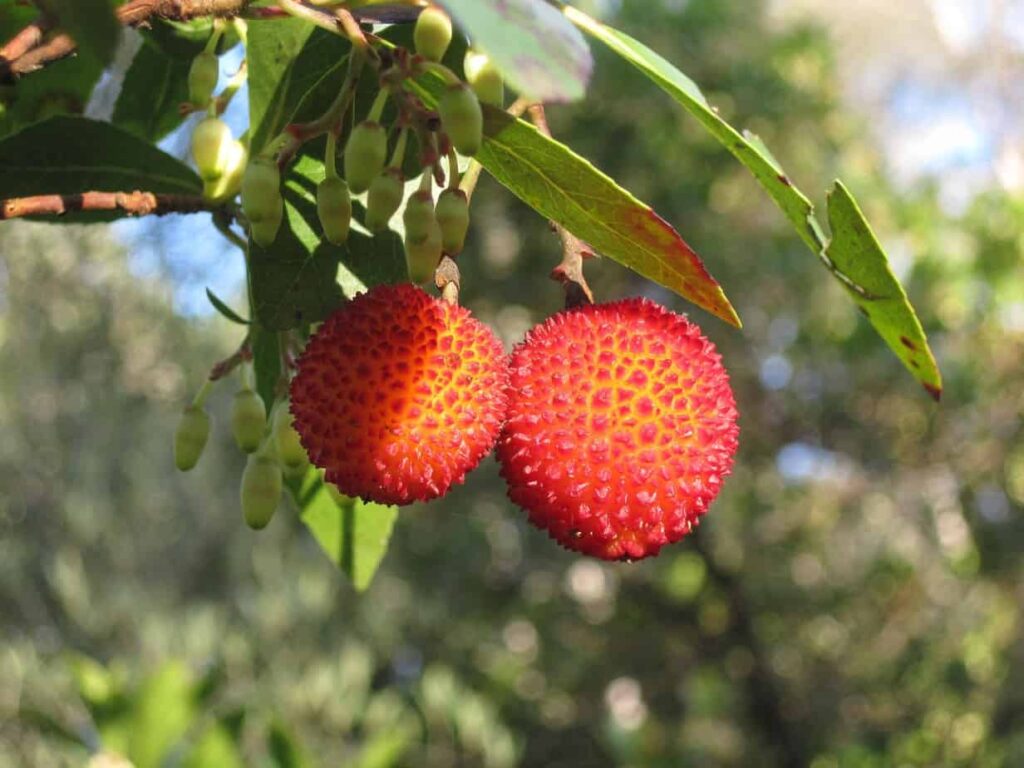
Tiny yet captivating, the edible fruits of the Strawberry Tree resemble miniature lanterns or textured orbs glowing in warm shades of orange, red, and yellow. Their bumpy surface gives an intricate, handcrafted quality, making each fruit appear like a work of natural art. Arranged en masse, the vivid hues create a mesmerizing ombre effect that feels celebratory and festive.
Mood and Style: These fruits bring a playful, harvest-inspired charm to centerpieces. Their small size and cheerful hues make them ideal for adding pops of color to rustic or seasonal decor.
Actionable Tip: String Strawberry Tree fruits together to create a whimsical garland, or use them as scattered accents on wooden tablescapes featuring pumpkins and greenery for an autumn-inspired look.
Tropical Curiosity: Nipa Palm Fruit

Nipa Palm Fruit, with its translucent, jelly-like husk, has an unmistakably otherworldly look. Often seen in delicate clusters, the fruit exudes a sense of fragility and purity. Its pale, icy tones—typically white or translucent with hints of cream—contrast beautifully against the darker green stems from which it hangs. Each individual fruit appears polished, reflective, and slightly oval, almost as though designed by nature to look like tiny, suspended pearls.
Mood and Style: The Nipa Palm Fruit evokes a cool, coastal aesthetic, making it an ideal addition to tropical-inspired settings or clean, minimalist designs. Its unique texture and appearance give off a tranquil, Zen-like vibe that enhances both interior design and culinary presentations.
Actionable Tip: Incorporate Nipa Palm Fruit clusters into spa-like settings alongside bamboo and smooth pebbles for a calming visual statement. For culinary use, display them in clear glass bowls to emphasize their alluring transparency and delicate beauty.
Botanical Gems: Pitanga (Surinam Cherry)
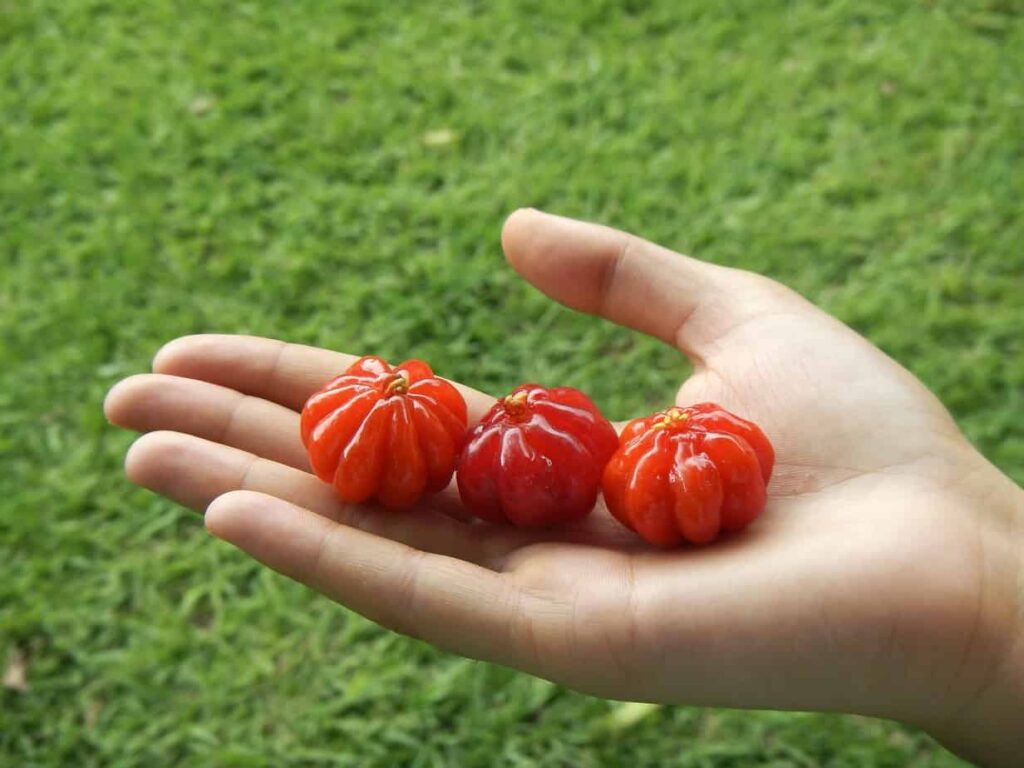
The Pitanga, or Surinam Cherry, is a dazzling display of vibrant shades that range from fiery red to deep orange, depending on ripeness. These ribbed, pumpkin-like miniature fruits have a glossy skin that reflects light beautifully, giving them a gem-like quality. Their petite size and unusual texture instantly draw attention, while their sweet-and-tangy flavor makes them a culinary delight. They’re often paired with greenery, creating a striking contrast that emphasizes their rich coloration.
Mood and Style: Pitanga’s bright and cheerful appearance is perfect for infusing playful energy into rustic or tropical fruit arrangements. Their small size and radiant hues make them ideal for whimsical, nature-inspired settings or as edible garnishes for summer cocktails.
Actionable Tip: Arrange Pitanga along elongated platters accented with fresh herbs for a colorful table spread, or place a collection in a copper or wooden bowl to complement their warm tones.
Sinister Beauty: Fly Honeysuckle
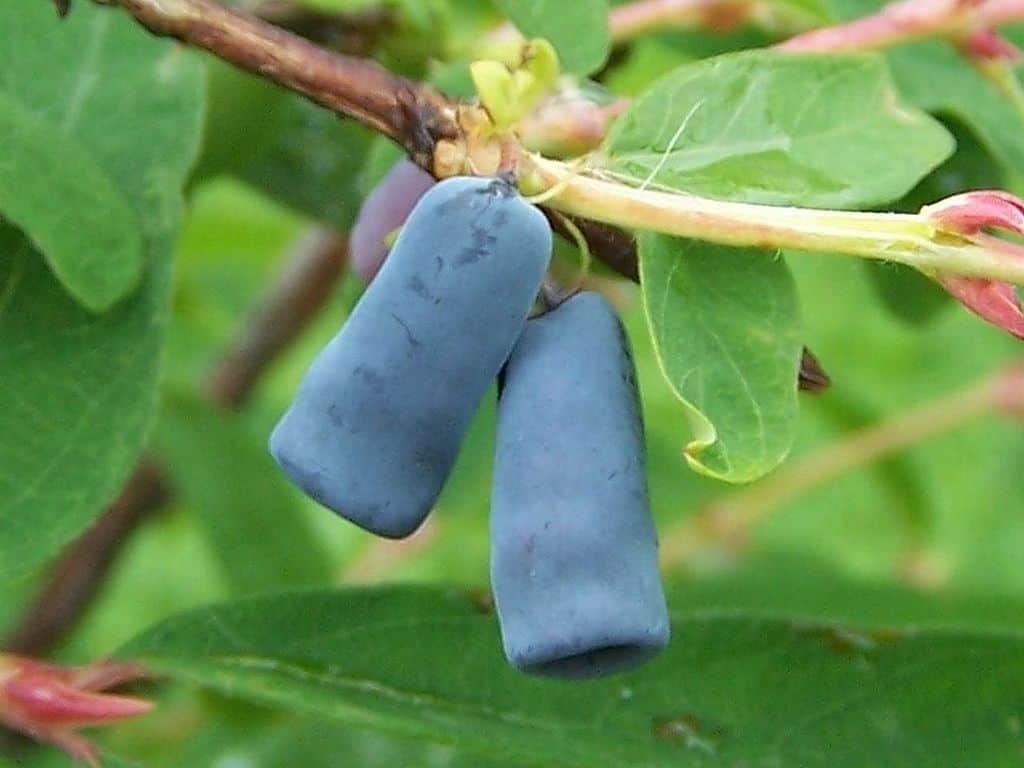
Fly Honeysuckle’s delicate yet striking twin red berries resemble glossy, alien-like orbs that seem almost too perfect to be real. Growing in pairs, the deep crimson fruit is supported by an intricate structure resembling a tiny green raft—an added detail that makes it visually captivating. The waxy sheen of the berries contrasts sharply with the matte greenery, lending it an enchanting yet slightly eerie quality.
Mood and Style: These vibrant berries have an ethereal, fairy-tale quality that suits woodland or enchanted forest themes. Their symmetrical pairing and bold coloration elevate their aesthetic appeal, making them perfect for creative table arrangements or whimsical garden decor.
Actionable Tip: Display Fly Honeysuckle berries in glass terrariums for a magical, nature-inspired visual. Pair them with moss or miniature pinecones for a centerpiece that evokes an enchanted forest vibe.
A Rare Ivory Treat: White Jamun

White Jamun, a rare and exotic variety of the more commonly purple Java Plum, captivates with its smooth, creamy-white exterior. The glossy fruits are slightly elongated, resembling miniature oblong pearls hanging in dense clusters. Their pale hue exudes refinement and purity, creating an almost celestial vibe. Their soft, marble-like finish emphasizes their natural elegance while offering an unexpected visual shift from classic fruit colors.
Mood and Style: The White Jamun feels chic and sophisticated, making it a standout choice for minimalist or monochromatic fruit arrangements. Its unique ivory tones add a sense of calm and understated elegance to any decor.
Actionable Tip: Pair White Jamun with dark foliage or deep purple fruits to create a subtle contrast that emphasizes its rare coloration. For a luxurious twist, display them on gold-accented or polished ceramic dishes.
Rustic Charm: Indian Plum

The Indian Plum is nature’s embodiment of rustic elegance, with its compact, oblong shape and muted green-to-yellow coloration. Its smooth and slightly glossy surface reflects the simplicity of organic beauty, while subtle texture variations add quiet depth. Often growing in clusters, the fruit evokes a quaint, earthy charm reminiscent of small village orchards and warm countryside aesthetics.
Mood and Style: Indian Plum brings a grounding, rustic atmosphere to any setting. Its muted green tones pair beautifully with natural wood and stone elements, perfect for creating a farmhouse or countryside-inspired tablescape.
Actionable Tip: Use Indian Plum in vintage metal or woven wicker baskets for a timeless, pastoral centerpiece. To incorporate it into culinary presentations, slice it thin and serve on rustic wooden boards alongside cheeses and fresh bread.
Sleek and Striking: Ceylon Olive (Elaeocarpus serratus)
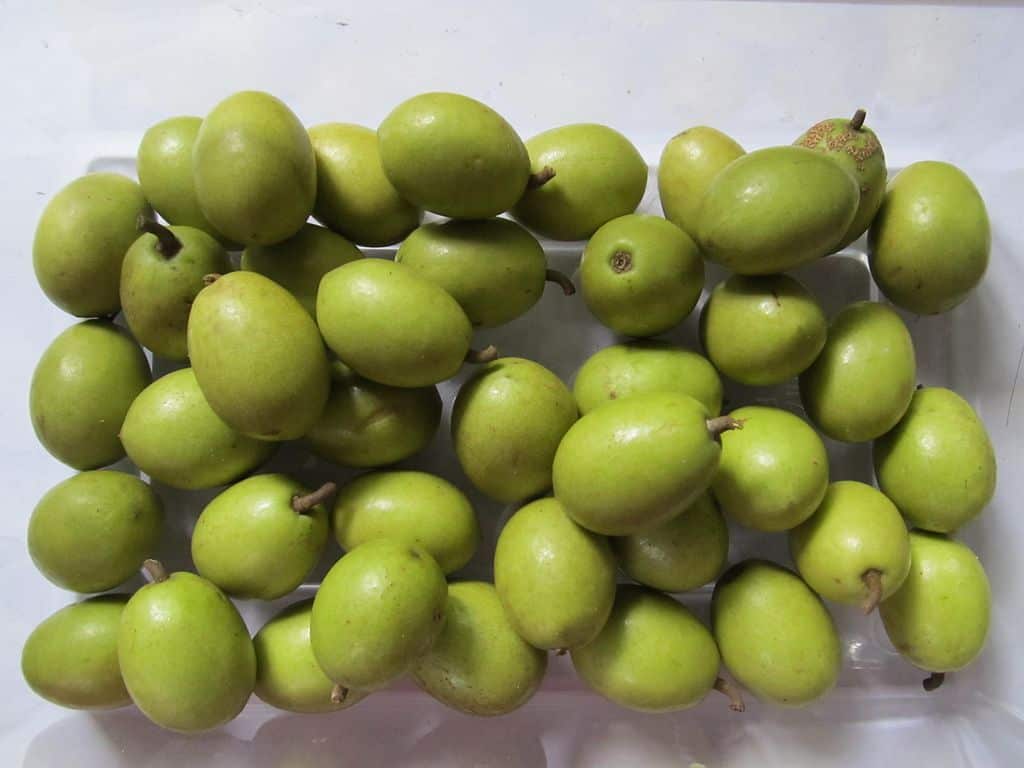
The Ceylon Olive, or Elaeocarpus serratus, showcases an elegant simplicity that feels both timeless and exotic. Its elongated, oval shape features a vivid green exterior, polished to a natural shine as if glazed by nature. The surface is smooth, with subtle tonal variations that give each fruit depth and character. This unassuming yet radiant fruit carries quiet sophistication, and its crisp, juicy texture lends itself gracefully to refreshing culinary creations.
Mood and Style: The Ceylon Olive evokes feelings of serenity and understated opulence. Its clean, green palette is well-suited for modern or minimalist styling, offering a versatile design element for kitchens and dining areas.
Actionable Tip: Arrange Ceylon Olives in a sleek glass bowl to emphasize their natural shine, or pair them with rustic stoneware for a more grounded presentation. Incorporate them into light salads for an aesthetic that’s as refreshing as the fruit itself.
In the fascinating world of alien-looking edible plants, nature proves that it is the ultimate artist. Each unique fruit—be it vibrant and spiky or smooth and symmetrical—presents an extraordinary spectrum of textures, colors, and stories waiting to be explored. These intriguing specimens not only elevate our plates but also inspire imagination and creativity, serving as focal points for decor or culinary innovation. Whether used as table accents, centerpieces, or the stars of show-stopping dishes, these plants remind us of the beauty and mysteries that lie just beyond the familiar. So, why not add a touch of the extraordinary to your kitchen or home decor and let these alien creations transport you to another world?






